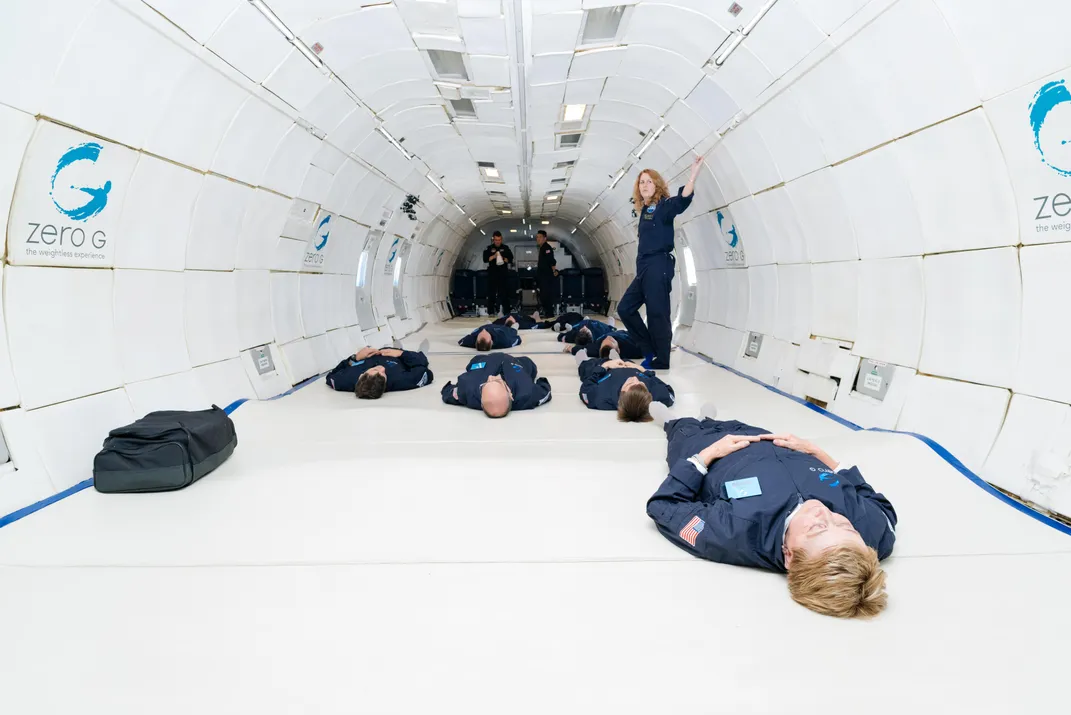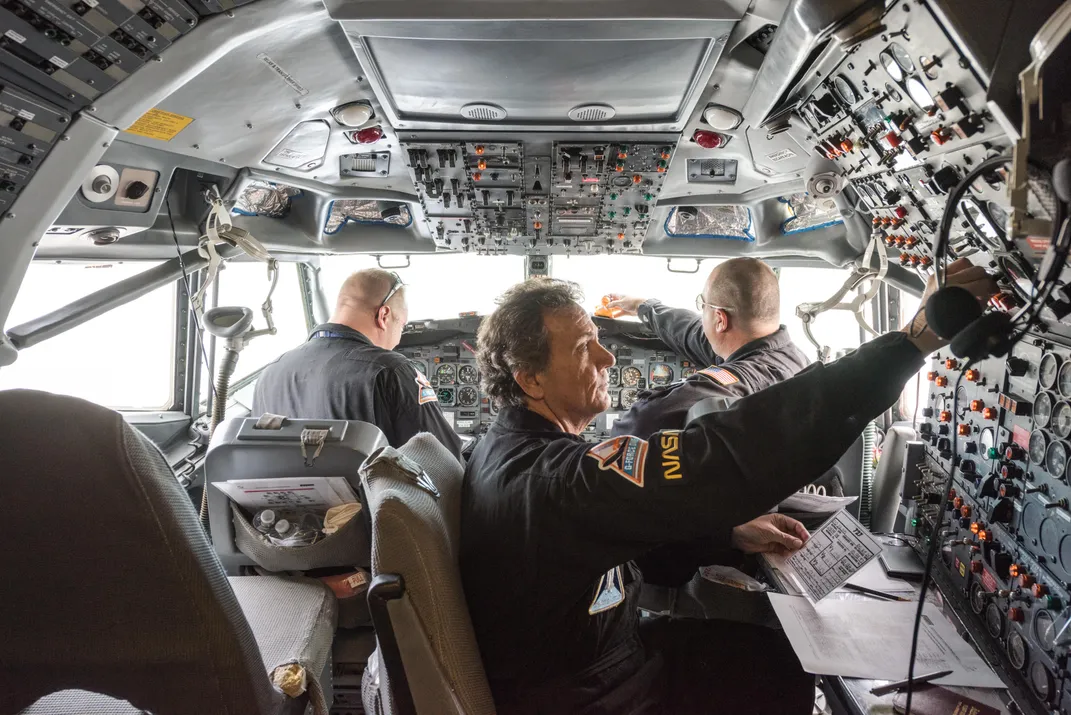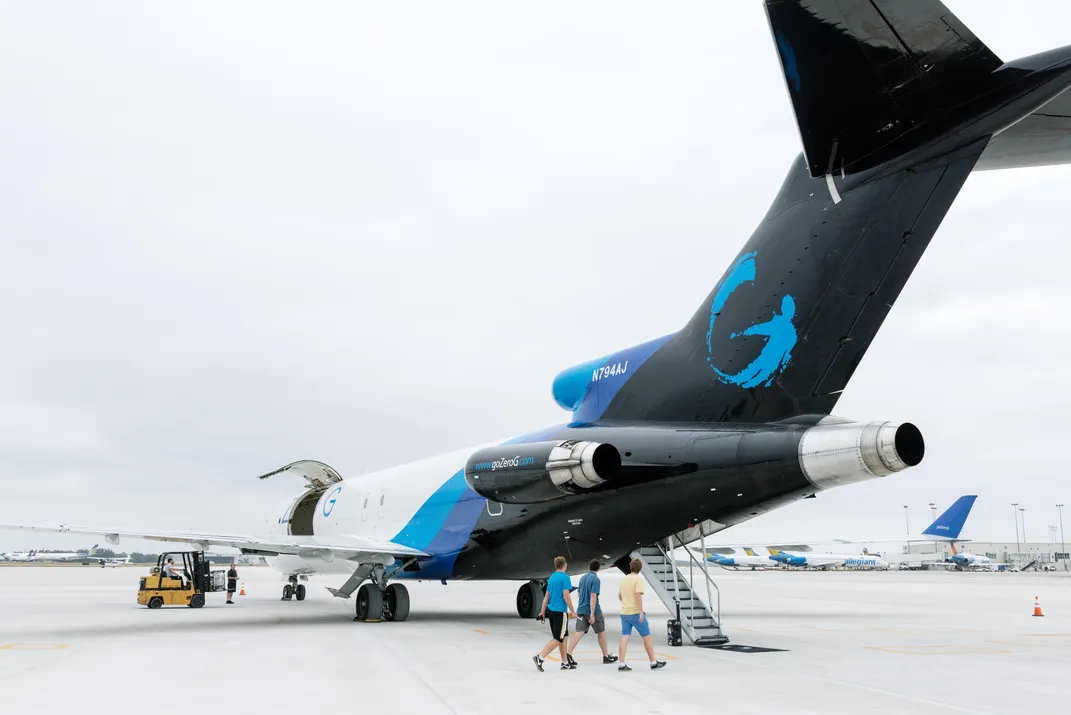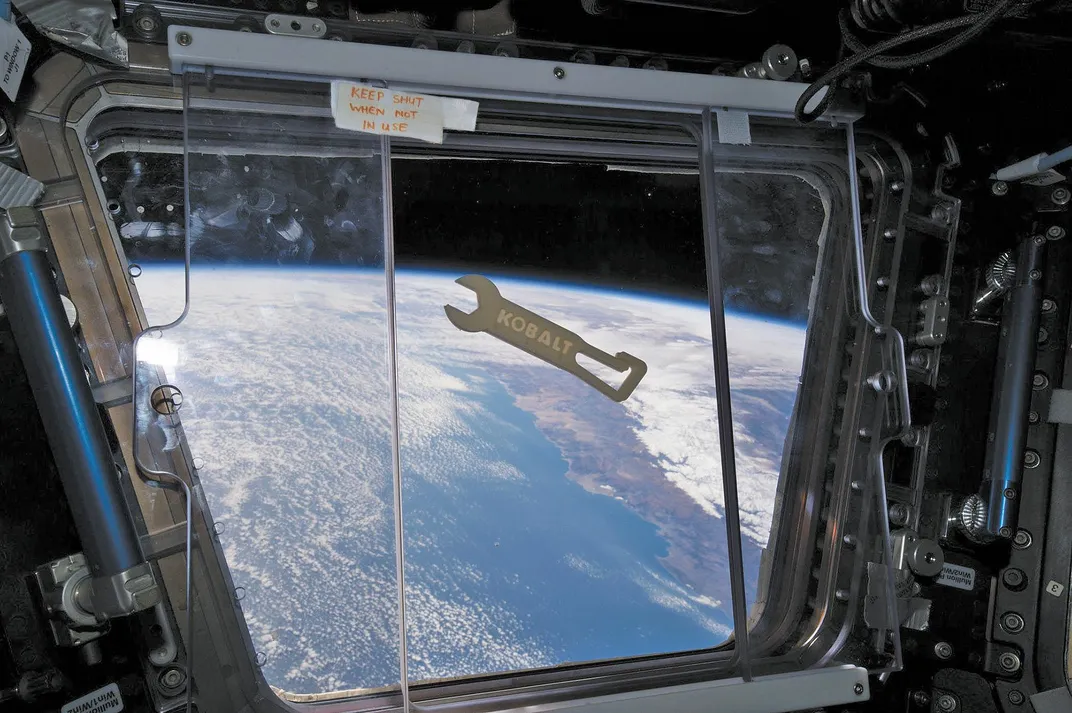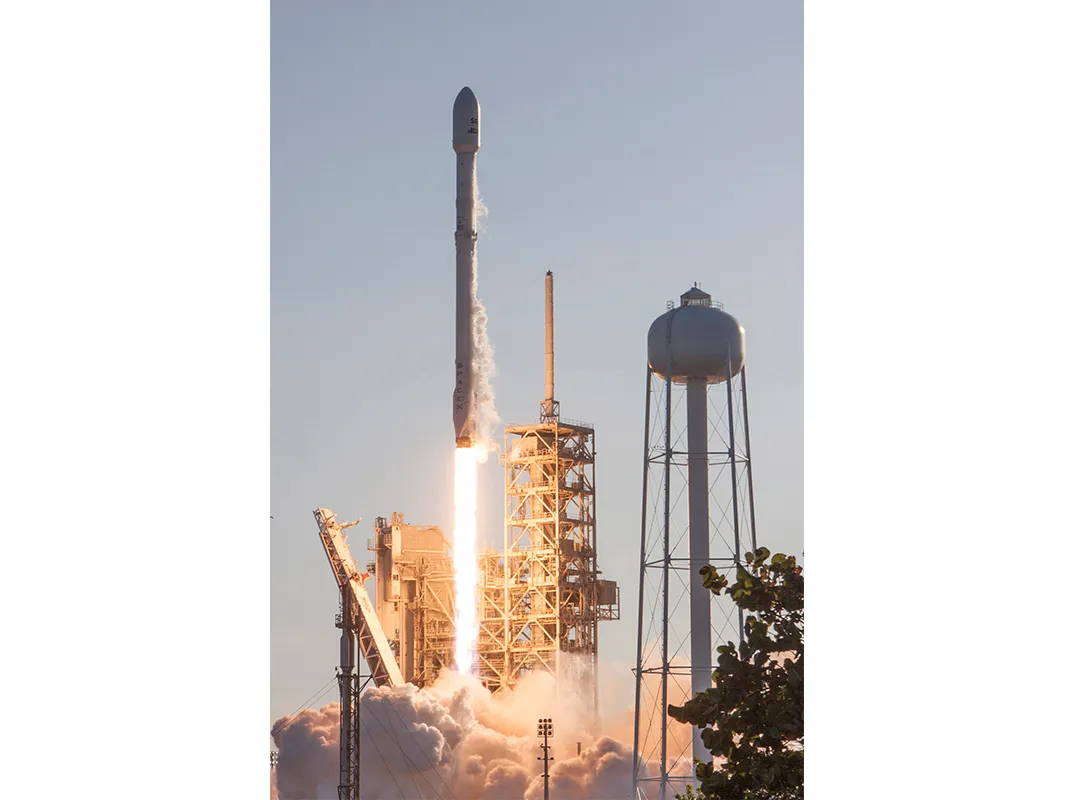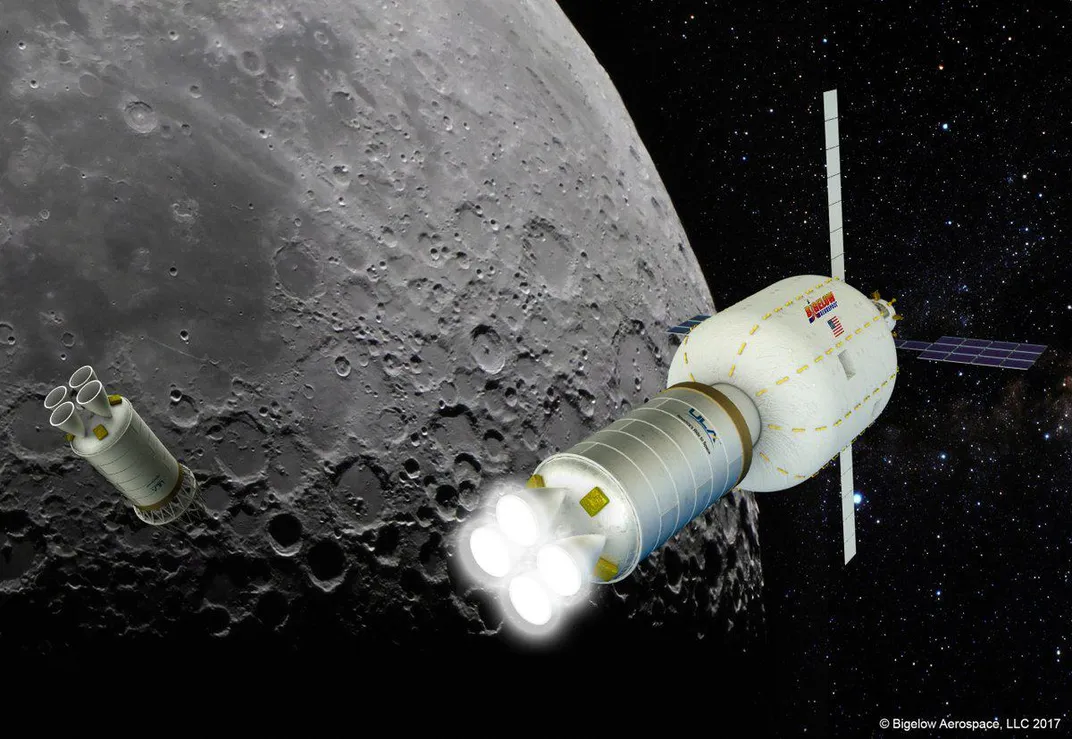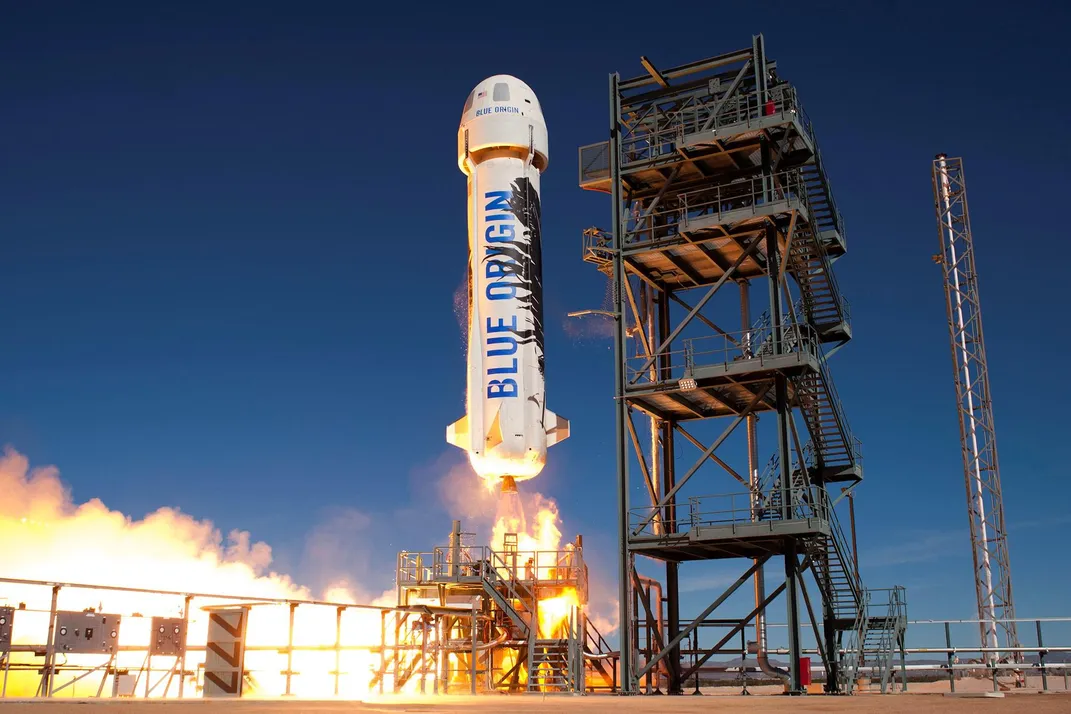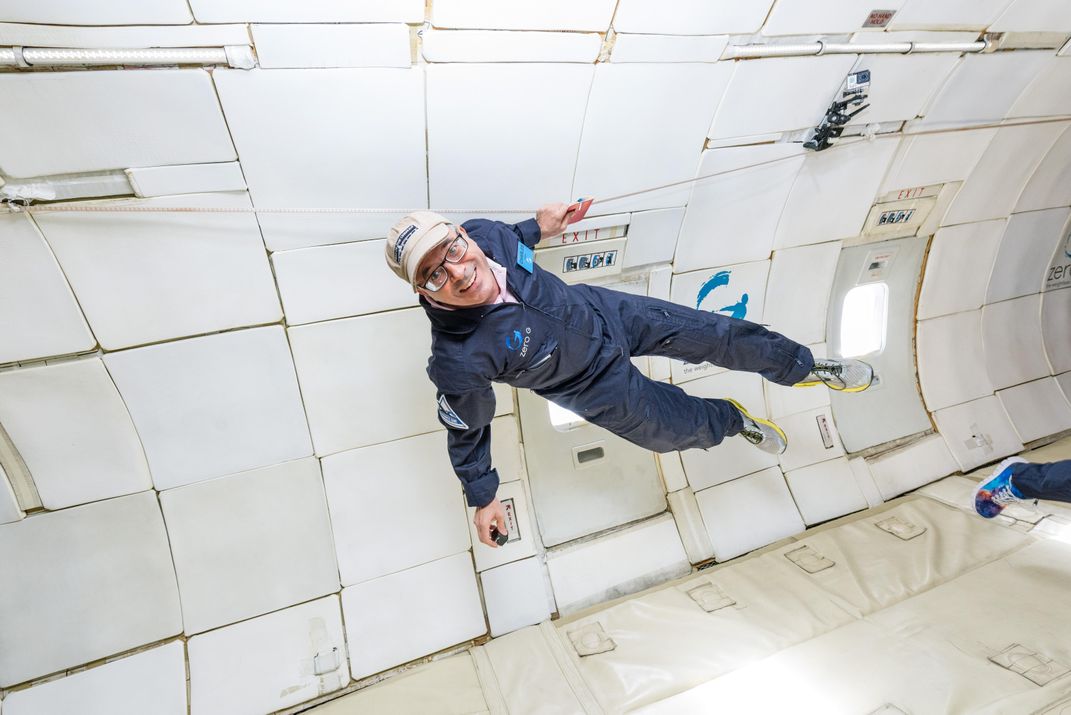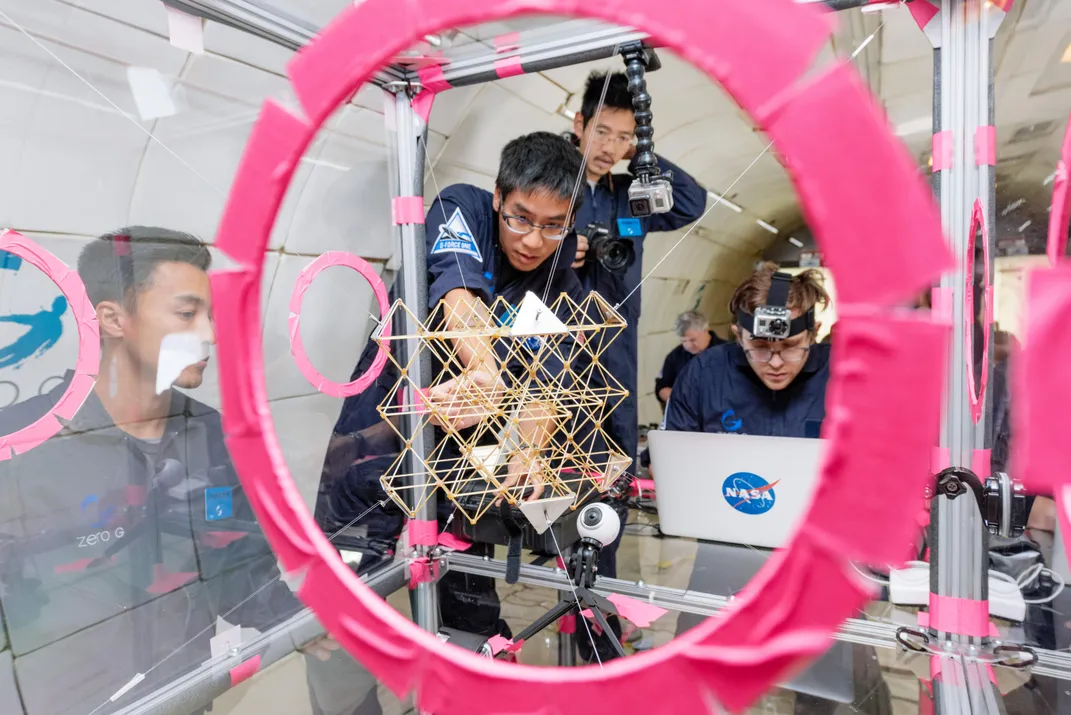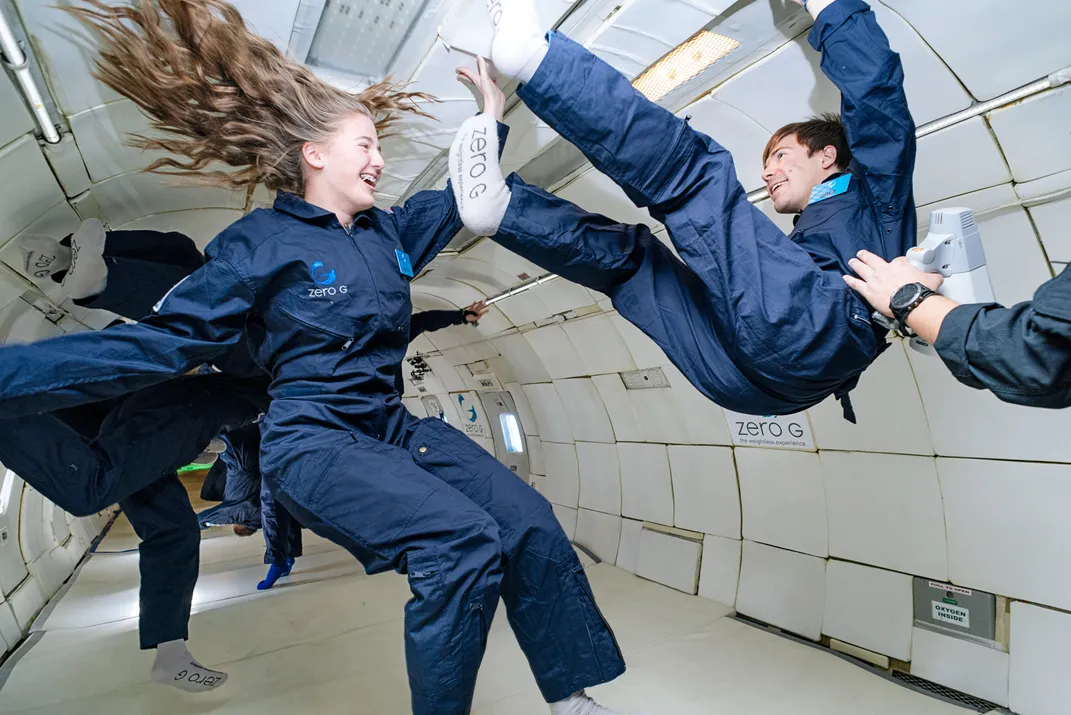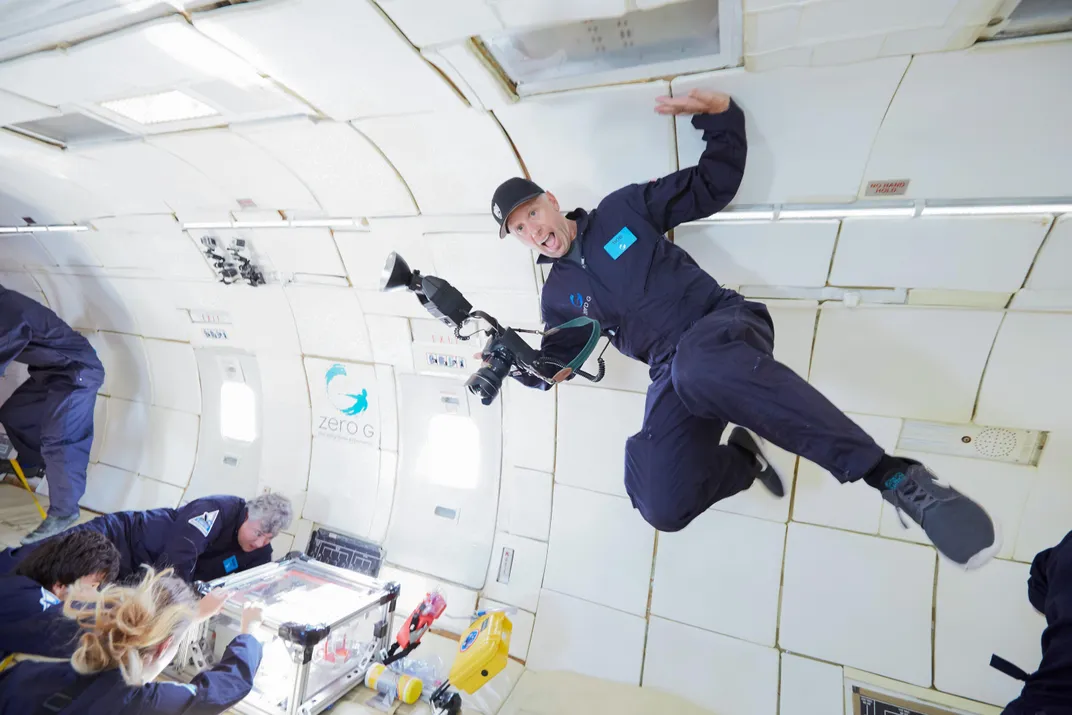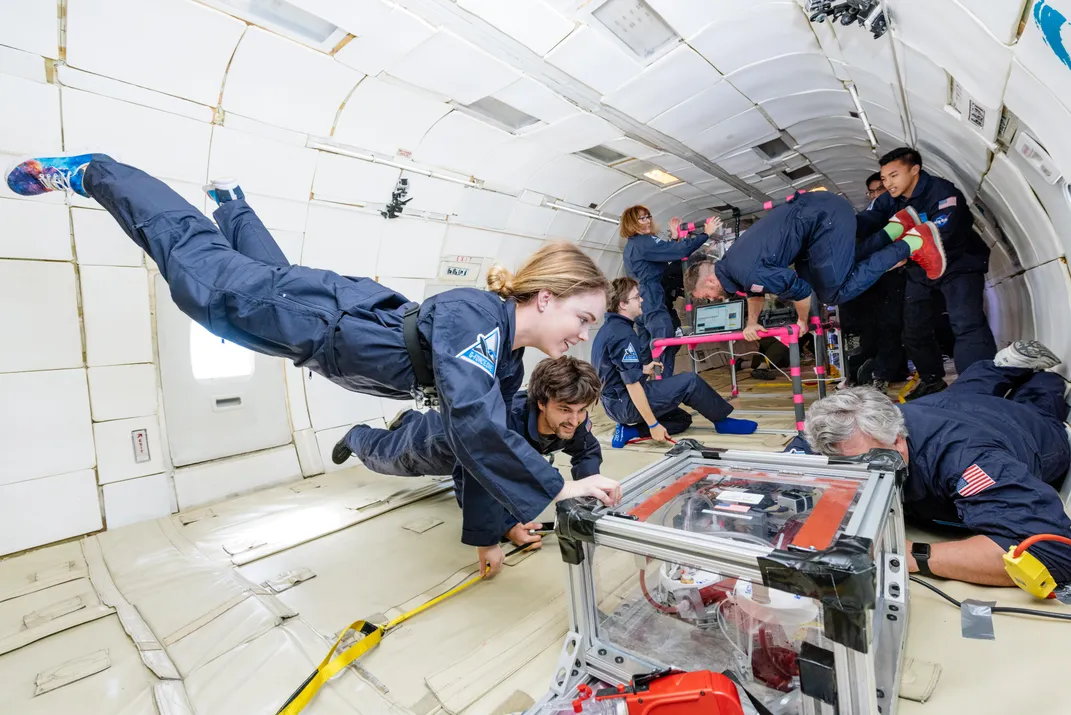The Future of Zero-Gravity Living Is Here
Entrepreneurs predict there will be thousands of us living and working in space. Our correspondent takes off to see what that feels like
/https://tf-cmsv2-smithsonianmag-media.s3.amazonaws.com/filer/2f/1c/2f1ce2b8-8c4a-4631-aeb0-4364de3cb8d5/jun2017_b08_zerogravity.jpg)
One moment I am my normal self, lying flat on my back, gazing at the ceiling. The next moment, I am released. My body drifts up from the floor, and there is no force on me at all from any direction.
I’m out over the Gulf of Mexico in G-Force One, a vintage Boeing 727 that belongs to the Zero Gravity Corporation. The plane, which provides scientists and thrill-seekers with the chance to experience weightlessness without going to space, has just seven rows of seats, way at the back. Instead there’s 66 feet of wide open space, the better to make the most of the kind of acrobatic flying that shakes passengers loose from gravity.
Around me, my fellow fliers quickly take advantage of weightlessness. Sixty-nine-year-old Bobbe, floating in the middle of the fuselage, curls up and tries a somersault. I scramble like a cartoon character who has raced off a cliff, arms and legs pinwheeling just before the fall.
I push myself up off the floor, and bam!, the ceiling whacks me on the back. You can be told a hundred times how little effort it takes to move when you’re weightless, but to actually calibrate it, to figure it out, you have to be in it. I grab for one of the guide ropes, and miss.
“Feet down!” yells a crew member named Robert. “Coming out!”
I don’t quite make it to the floor before gravity grabs me hard, but without a sound. The physics of these flights is such that we go from weighing nothing—from zero G—to feeling like we weigh close to twice what we normally do. At two G, you have a sensation of being pinned down.
The last 27 seconds have been unlike anything I’ve ever experienced. Few others have had that chance.
But that’s about to change: Weightlessness is not only about to be democratized. It’s about to become a lifestyle.
**********
We are on the verge of a zero gravity era.
If the new-wave space entrepreneurs manage to radically change the economics of space travel as they promise to do, kids in high school today could spend a slice of their careers working in space, not as astronauts but the way a young diplomat or banker today might take a posting in London or Hong Kong. By 2030, it’s possible that many dozens of people at a time will be working and living in space. (These days, typically, there are six people.)
The zero gravity era will mark the moment when you no longer have to be special to go to space. You might be a scientist or an engineer or a technician (or a journalist); you might be going for a one-time, two-week research effort or rotating in for your usual six-week posting. But in the zero gravity era, going to space will be no more dramatic than helicoptering out to an offshore oil rig. Exotic, specialized and more dangerous than staffing a cubicle—but not rare or restricted.
A constellation of commercial outposts will be serviced by a fleet of reusable spaceships. A rocket could go to orbit every day, compared with just 85 launches worldwide in 2016. Those rockets could carry dozens of people, and head to laboratories, factories and tourist resorts a few hundred miles up in low-Earth orbit, or they could be stationed farther out, between the Earth and the Moon. Eventually, they will service outposts on the Moon itself (a three-day trip) and possibly Mars.
Of course, we’ve been anticipating a true space age since “The Jetsons” debuted in 1962, seven months after John Glenn first orbited the Earth. The Apollo missions to the Moon were going to pave the way for human settlement of the solar system. NASA promised the space shuttle would fly 580 missions during its first dozen years of operation. Instead, the shuttle fleet flew 135 missions over 30 years and was decommissioned in 2011. Instead of 48 flights a year, it averaged four.
What makes this moment feel different is not a new government-backed space race but the soaring ambitions of entrepreneurs backed by reservoirs of money, top-notch engineering talent and increasingly refined technology. Amazon founder Jeff Bezos, now the world’s second richest man, is using his personal fortune to make cheaper, more reliable, reusable spaceflight technology, with the goal of getting us all off the planet. Twenty years from now, Bezos says, he wants Blue Origin, his spaceflight company, to have “put in place all the infrastructure, so a new generation can have this incredible dynamism in space.” His goal, he is not shy to say, is “millions of people living and working in space.”
Bezos’ strategy is to drive down the price of a launch, pull in customers, postpone profits and create the extraterrestrial economy he wants to dominate.
He has already made significant strides: In 2015, Blue Origin launched its New Shepard rocket 62 miles above Earth, to the edge of space, before landing it, upright, near the launchpad. Nine weeks later, the company relaunched the same rocket, which it did a total of four times in 2016. Nobody had done it even once. In April, Bezos said he would sell $1 billion of his Amazon stock each year to fund Blue Origin.
Elon Musk, founder and CEO of SpaceX, has the same determined approach, and SpaceX is already occasionally profitable. The company ferries cargo to and from the International Space Station for NASA, using rockets it designed and built. In March, SpaceX bested Blue Origin. It launched a satellite to orbit, using a refurbished rocket, the first time the same rocket was used twice to send cargo to orbit. Orbital rocket boosters, which travel much higher and faster, are harder to recover and reuse. “At this point, I’m highly confident that it’s possible to achieve at least 100-fold reduction in the cost of space access,” Musk told reporters afterward, echoing words Bezos has used. The idea is that if a launch that today costs $100 million can be had for $1 million, customers for space will line up.
One of those will be Robert Bigelow, a Las Vegas real estate magnate and entrepreneur who is using layers of high-tech fabric to build expandable, modular space stations that are roomier, cheaper and reportedly safer than traditional metal-can modules. His company, Bigelow Aerospace, has launched two small test habitats on its own, and has a third bolted to the Space Station right now. Bigelow wants to do in orbit what he’s done on Earth: Build useful structures and lease them out. Research labs, tourist cabins, manufacturing pods—Bigelow’s space stations will be designed for Earth orbit and equipped to order for non-astronaut customers.
A California company called Made In Space may be just the kind of tenant Bigelow seeks. It is pioneering a new category of imports—products manufactured in space and sold to Earthlings. In April 2016, the company outfitted the Space Station with an automated 3-D printer that produces several test items a week for NASA and other customers using designs beamed up from Earth. Later this year, it will install a test module on the ISS to manufacture a specialized kind of optical fiber that, the company says, could improve by many times the speed with which we move data on Earth. “This could be the first truly industrial use of space,” says Andrew Rush, the company’s CEO.
Space isn’t a stranger to profit, of course; there are hundreds of commercial satellites in orbit. But the big drivers of space exploration like NASA have tended to focus on advancing science and technology more than on dollars. “Space historically has not been populated by people who want to make money,” says Carissa Christensen, CEO of Bryce Space and Technology, an aerospace research and consulting firm. “It’s been populated by people who want to go to space, and the need to find somebody to pay for it was sort of an annoying secondary consideration.”
For the new-wave entrepreneurs, money isn’t an impediment. It’s the motivation, and the lubricant. And now a kind of market ecosystem is taking shape. Bezos can’t reach his goal of 100 rocket launches a year until there’s somewhere for the rockets to go. Bigelow can’t put space stations in orbit until there’s a reliable, affordable way to transport those structures and their tenants. Made In Space needs somewhere to put manufacturing equipment, and it needs cargo ships to take raw materials up and bring finished products back.
This kind of space economy is “absolutely coming,” says Christensen. “If you look at everything that’s happening all at once, there has never been anything close to this before.”
**********
And yet, to get from here to there—from six people living aboard the International Space Station to 60 or 600 traveling in Earth orbit and beyond—we will have to grapple with challenges that the enthusiasm of the entrepreneurs can frequently camouflage: Life without gravity is really hard. Weightlessness changes the food you eat, how you prepare that food, and how your body digests it.
Weightlessness changes how you work, how you exercise, how you sleep. “In zero G, a lot of things happen to the human body, and none of those are particularly good,” says John Connolly, the lead engineer on NASA’s Mars Study Capability team. Gravity—or, more precisely, resistance to gravity—is the force that gives our muscles their power, and gives our bones their strength and durability. Older women on Earth lose about 1 percent of their bone mass a year. Without exercise, astronauts in zero gravity lose 1 percent of their bone mass a month. So Space Station astronauts exercise two-and-a-half hours a day, and NASA schedules exercise as a part of the daily work routine.
Still, there is no getting around the readjustment once an astronaut who’s spent significant time in space returns to Earth—or Mars, for that matter. “You’re dizzy, you’re nauseous, the blood in your body shifts down to your legs when you stand up,” says Scott Kelly, who spent 340 consecutive days aboard the Space Station, a record duration for an American, before returning to Earth in March 2016 after completing his fourth and final trip to space. “And there are also the things that you can’t see—the effects of radiation, effects on your vision.” It turns out that zero gravity reshapes your eyes, and it happens so quickly that astronauts with perfect eyesight travel to the Space Station with a couple of pairs of eyeglasses designed to correct their vision when it starts to change.
Largely because of such physiological challenges, the question of how to get astronauts to Mars and back, about an eight-month flight each way, remains unresolved. Some experts, including at NASA, believe the only practical solution for people planning to spend much more than a year or so in space is to manufacture “artificial” gravity, by designing spacecraft that can spin, creating centrifugal force to mimic some of Earth’s gravitational force. How to design such a spacecraft is “one of the big questions,” says Connolly, who also cautions that this approach could cause as many problems as it solves. “There are lots of benefits, but in practical terms a spinning spacecraft creates lots of engineering challenges.”
And none of this addresses the psychological difficulties of prolonged space travel: the dynamics of a small crew in a sealed space combined with isolation from loved ones and the world back home. “Being in space for ten days has almost nothing in common to living on the Space Station for long periods of time,” says Kelly. “I’ve been in space with 40 people, and some of them don’t do that great. I don’t think it’s a place for just anyone, or that anyone can live and work for long periods of time. It takes a certain type of person.”
Plus, he adds, there’s the jack-of-all-trades skill set required for those spending weeks or months alone or in small groups. “You need to not only be the pilot,” Kelly says. “You need to be the mechanic, the plumber, the electrician, the IT person, the doctor, the dentist. I mean, you need to be a very multi-skilled, well-rounded individual who can also deal very well with adversity.”
**********
Three days after my tourist flight, I reboard G-Force One, along with six scientific research groups, to get a chance to observe others actually trying to get some work done in weightlessness. On G-Force One, you never leave the planet’s gravitational field, of course. What the jet achieves is controlled, high-speed free-fall. Once airborne, it flies a series of roller coaster-style parabolas, climbing at a 45-degree angle (about three times that of a typical passenger jet’s ascent), reaching a peak, then streaking down the other side of a ten-mile-long hill. During the brief interval when the plane approaches the top of the parabola and noses over, the plane falls out of the way of its occupants at exactly the same rate its passengers are falling to Earth, and for those seconds, the aircraft wipes away the effect of gravity.
G-Force One gives scientists their best chance to work in zero gravity without having to go to the Space Station, and they pay tens of thousands of dollars, often using grants from NASA, for the privilege of performing experiments 27 seconds at a time. One group, led by an emergency room doctor from Richmond, Virginia, and assisted by undergraduates from Purdue University, is testing a system for reinflating a collapsed lung in zero gravity, complete with pints of expired blood. Researchers from Carthage College, in Wisconsin, are testing a new method to use sound waves to gauge the fuel in a spacecraft’s tank, which is notoriously hard to measure in zero gravity. A group from the Applied Physics Laboratory at Johns Hopkins University is testing a technology to allow small probes that land on asteroids to reposition themselves in ultra-low gravity without pogo-ing back into space.
Carefully padded boxes containing each group’s experiments are loaded through the plane’s cargo door and bolted to the floor. The Zero Gravity staff installs straps and handholds near the experiments, so researchers can work their equipment or tend their laptops as the plane soars in and out of zero gravity. But no matter how much planning has been done, how veteran the crews are or how much Velcro the equipment is secured with, the first flight parabolas are total chaos. It’s hard to get the equipment to work, it’s hard to keep oriented, it’s hard to simply type and stay in one place.
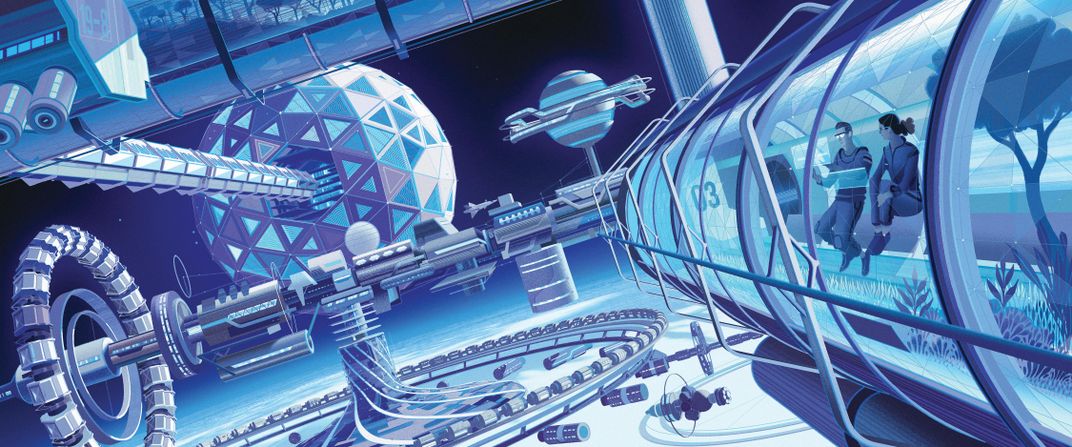
The G-Force One crew always books several days of research flights back-to-back, because researchers return from Day 1 astonished at what they’ve learned, or failed to learn, and spend the afternoon refining their equipment and procedures so they can take better advantage of Day 2.
Marsh Cuttino, the Virginia doctor leading the lung experiment, sets up his equipment near the back of the plane. Inside a polycarbonate box are three pints of blood in a pouch, which is attached via plastic tubes to a clear, funnel-shaped plastic device of Cuttino’s design, about the size of a shoebox, which in turn is attached via more tubes to a suction pump.
When somebody’s lung collapses after an accident, doctors insert a chest tube to drain the blood and air that’s leaked into the chest cavity and is preventing the lung from reinflating. The procedure is relatively straightforward in an Earth-bound ER. In space, it’s dramatically complicated by the fact that without gravity, blood withdrawn from a patient is dangerously filled with air bubbles and cannot then be safely retransfused.
Cuttino’s device, now in its third iteration, is designed to separate an injured space traveler’s blood from air, allowing the lung to reinflate, and collect the blood inside the funnel for transfusion. If it works, the pump will pull blood into the funnel, which has plastic ribs running along its interior, creating extra surface to slow the blood while air percolates out and is sucked through the device’s other end.
Cuttino and his students video the process so they can study how the blood flows through the device, which is impossible to observe in detail when flying up and over 25 parabolas.
On Day 1, somebody sets the suction pump on a setting that’s too high—and all the blood is quickly sucked through the apparatus. Then Cuttino’s students get airsick. On the second day, having readjusted the suction pump, Cuttino finds that the device’s new design works perfectly for the first time—the blood is cleanly emptied from its pouch and collected inside the funnel. “The effectiveness turned out to be much more geometrically dependent than we predicted it would be,” Cuttino says afterward. “That’s exactly the kind of thing we couldn’t have figured out without going to zero gravity.”
And yet 27 seconds of zero gravity, even repeated 25 times in a row, has its limits for extrapolating a device’s usefulness in real-world situations, and Cuttino has already contracted with Blue Origin to fly a fully automated version of the experiment on a New Shepard rocket later this year; that will yield three minutes of uninterrupted zero gravity.
Paul Reichert, a research scientist at Merck pharmaceuticals, has been an advocate for zero gravity drug development for 25 years. Weightless drug manufacturing, he says, would enable engineers to better control chemical processes, especially when it comes to synthesizing complicated large-molecule medicines. Reichert has never left Earth, but he has designed more than a dozen experiments performed by astronauts aboard the space shuttle and the International Space Station. Still, progress is slow. “I’ve done 14 experiments in space in 24 years,” he says. “I can do 14 experiments in a day here on Earth.”
Kelly hopes that more pharmaceutical experiments will be done on the Space Station, but he says an even better research site is the Moon: “It’s perfectly designed, and placed at a good distance. It’s got a sixth of the gravity of Earth, and has no atmosphere.” And if we are really trying to get to Mars, there isn’t a better lab for experimentation. “It seems like a perfect place to practice.”
**********
One of the most alluring opportunities for transforming exploration in Earth orbit and beyond comes from an old industry—mining. Even near space is full of rocks containing huge amounts of precious materials, including metals such as iron, gold and platinum.
Chris Lewicki, the CEO of Planetary Resources, aims to figure out how to tap those asteroids. Before he co-founded the company, in 2009, Lewicki spent nine years as a NASA engineer, including as flight director of the Mars rovers Spirit and Opportunity. For the time being, Planetary Resources is focused on arguably the most valuable resource for space exploration—water, which can easily be separated into hydrogen and oxygen to make rocket fuel. An asteroid as small as a kilometer across could contain enough water to make more fuel than has been used by all the rockets ever launched, Lewicki says. Space outposts will also need water for drinking, sanitation and as a source of oxygen, for breathing. And in space, water is easy to transport, because it’s found as ice. Just harvest the ice robotically and haul it back to a mostly automated processing facility, where a handful of human tenders might cycle in for short stints of a few weeks at a time.
“Water is the first step,” Lewicki says. “But after that, there’s plain old construction metals—iron, nickel. Not to bring to Earth, but to use in space.”
Planetary Resources is a few years from launching its first prospecting satellite, which will scout for water on nearby asteroids. And Lewicki acknowledges that a series of technological innovations, from robot asteroid miners to refillable rocket fuel tanks, need to be developed before a self-sufficient space economy takes hold. But he insists it will happen, and asteroid mining will play a critical role: “The leap we’re making is that this is all going to scale one day to millions of people living and working in space. And the only way to do that is to use ‘on-site’ resources.”
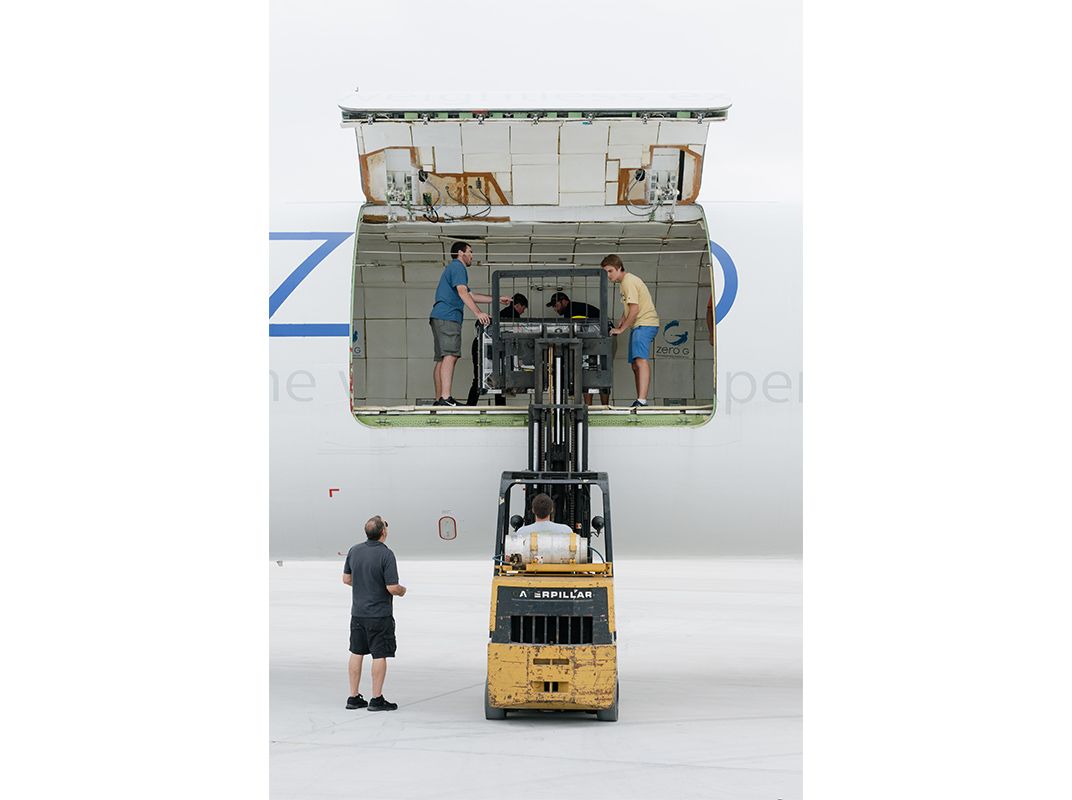
His vision, he says, is space’s equivalent of the Interstate System of highways. “What an enormous investment that was. But how it transformed personal and commercial transportation in the U.S.” And that, in turn, transformed cities, markets, whole economies, even the way we see ourselves, as mobile citizens.
It’s worth remembering that sometimes single companies, headed by single-minded personalities, really do drive massive change. Think of Ford, Netscape, Google. “Here’s what’s incredibly important about Jeff Bezos’ presence in the industry right now,” says Christensen, of Bryce Space and Technology. “It doesn’t really matter to him whether you think what he’s doing makes sense or not. He doesn’t need your money.”
Lewicki believes the vision of a new space economy is real. “It’s inevitable,” he says. “It’s definitely inevitable. I’m upset it hasn’t happened already.”
**********
A few parabolas into my G-Force One tourist flight, I arrange myself face-down instead of on my back. As we soar over a crest, I feel gravity let go of my body, like being scanned by a force field. I use an index finger to cast off, just a poke at the mat, and suddenly I’m a foot off the floor. I ease into a sitting position. Others around me have begun to get the hang of it and are doing tricks. Someone drifts my way and I redirect him with a single touch.
During the next loop, I fish a notebook from my thigh pocket and park it in the air right in front of me while I retrieve a pen from another pocket. Then I reach over and pluck my notebook from exactly the spot where I’d left it floating. I’ve been counting on gravity for 487,464 hours of my life, and after four minutes of zero G, it is the most natural thing in the world to set my notebook adrift in midair and expect it to be there seconds later.
One thing that’s surprising, I realize later, is there’s no sense of falling. There’s not even a fear of falling, the way some people feel looking over the edge of a tall building. You’re floating up there at the top of the plane, yet your body sends no signals of alarm.
Instead you are totally released from all force, from all pressure—in zero gravity, you have the freedom of a helium balloon, you are the helium balloon, and you can feel that sense of freedom, not just in your gut but in your joints, your muscles, on your skin, inside your mind.
It’s like meditation for the whole body, a Zen trampoline, and I don’t want it to end.
Related Reads
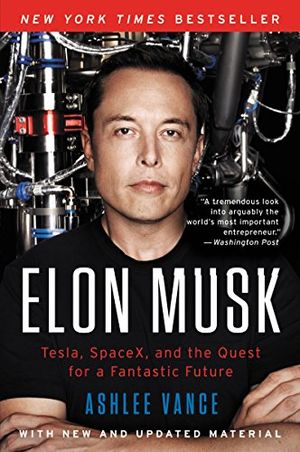
Elon Musk: Tesla, SpaceX, and the Quest for a Fantastic Future
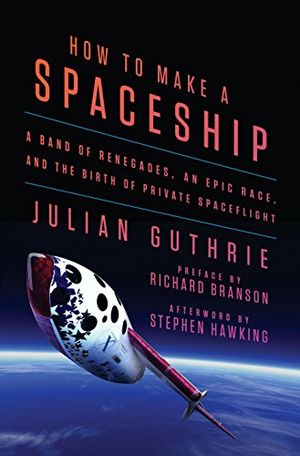
How to Make a Spaceship: A Band of Renegades, an Epic Race, and the Birth of Private Spaceflight
